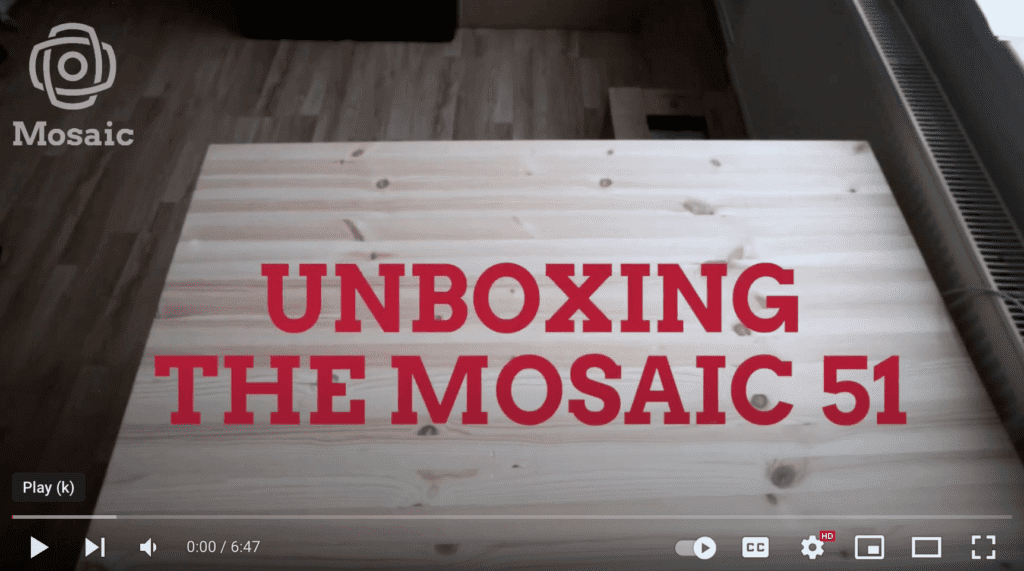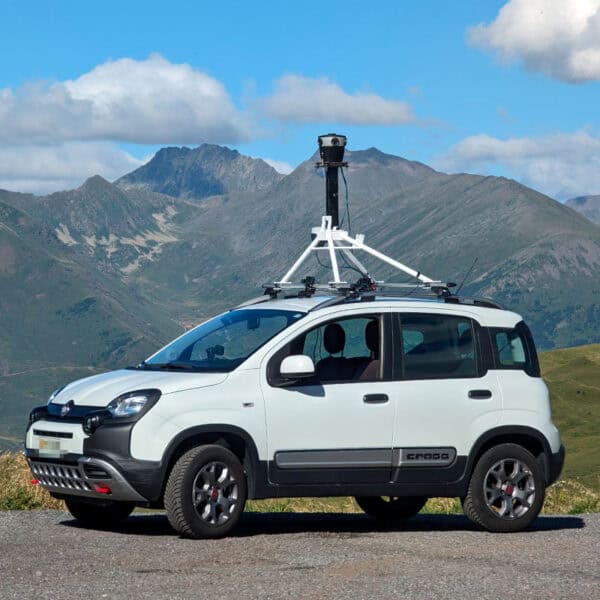An in-depth exploration of our Mosaic 51 camera system and its respective features.
It’s been over 2 years since we first sat down with our CEO Jeffrey Martin to ask him about Mosaic, what brought him to the mobile mapping market and where the company was at the time.
Check out that interview here →
A lot has changed for Mosaic in those 2 years. We went from being a nearly unheard of company, to one which is now integrating with some of the leaders in the mobile mapping and geospatial industries (including Riegl) and supplying cameras to industry giants like Field (read their case study here).
We thought now was a good time to check back in to see how things are going and what it is that has shaken up the mobile mapping camera sector.
Martin shared some of his thoughts on why customers have come around to Mosaic and answered the question he and his team are often asked:
Why are your cameras better than the competition?
Let’s run through the major engineering points and why they are so beneficial for mobile mapping, plus for a bounty of other uses. Then you’ll see why!
Durability
Mosaic talks a lot about the durability of its camera systems, can you talk us through the main features?
No Sweat
Absolutely. So, take a look at our Mosaic 51 camera system, a compact model which we designed with ribbed edges known as ‘heat sinks’.
We thermally connected these to the computer inside, so when the camera is exploring the streets the wind runs between the ridges and cools the interior system. This ensures the system is maintaining optimum temperature to be able to run for as long as you need.
The Mosaic 51 is not only compact but watertight and dustproof, and excelled in all tests our lab threw at it to ensure it could survive the elements.
It has also sat atop a car for weeks at a time, bracing against rain and snow, and our customers commented that it didn’t break a sweat in the hottest conditions. Amazingly, the Mosaic 51 is in use across North and South America, Asia, Africa, and the Middle East, and we haven’t received one complaint that the camera is having difficulties in the heat.
One customer commented as such
We were capturing in Colombia for 500 kilometers, in more than 40º C and the camera worked all day, without any trouble or issues.
Gustavo Guevara, Dymaxion
Encased SSD
The SSD resides inside the camera. That itself can get a little warm, but we’ve designed the framework in such a way so that the heat is expelled outwards, causing no issues or disruption to the internal runnings.
Shielded Lenses
Oil and scratch-resistant glass protect our lens against the elements and unruly pebbles from gravel paths. We also encompassed them entirely with additional waterproof and dustproof seals. Should the lens experience any damage, they are easily removed and replaced, meaning minimal wait time to get back on the road.
Our customers really appreciate this element, as there is minimal disruption to their work, so they aren’t worrying about running over a timeline or over their budget.
Resilient Mounting
How is the Mosaic 51 attached to its ride?
We have high-strength screws in place to affix it, to a roof rack of a vehicle, but we have also fitted robust security keys. In the unlikely event of an unexpected impact, the camera system will hold fast with barely a shudder, thanks to these multiple locks in place.
Unexpected, and Overcome Challenges
Has this been rigorously tested?
Certainly! On one occasion we received an email from a customer, explaining that their Mosaic 51 took an unanticipated ding when the driver pulled into a parking garage with a low overhang.
The roof (luckily) was no match for the camera system, however. The impact succeeded in peeling back the roof mount and breaking a portion of their car, but our camera remained fixed in place.
There was some cosmetic damage (the guy did drive it into a roof) but the internal system itself was untouched, undamaged, and remained to be fully functional.
The Connectors
How about the connecting cables, are they just as robust?
Yes. Industrial-grade and waterproof, our connectors for the power, ethernet, antenna, and auxiliary port are super heavy-duty. Every connector screws in (so there is no danger of anything coming loose) and each is rated for tens of thousands of mating cycles, so again, no fear of accidental disconnect, resulting in wasted time on recapturing data.
Specialized Auxiliary Port
This we are rather proud of. A lot of time and effort has been put into the engineering of our auxiliary port. Customers can easily connect the below external devices:
- GNSS
- INS
- IMU
- LiDAR
- Wheel encoders
So if a customer already has the above systems and wishes to synchronize their sensors with the Mosaic 51, they can do so with minimal engineering. When compared with other models on the market that have complicated attachments, our camera really does come out on top.
Clear Optics
Image quality is key for a camera system, can you walk us through your optics in more detail?
The optics were carefully considered. Our 12k resolution Mosaic 51 camera system has 6 x 12-megapixel image sensors. This configuration of lenses and sensors is the perfect balance required to cover a full 360° scope, between the lens field of view and the number of image sensors.
Cameras with only two lenses can capture data, but the resolution will waver in quality, due to the overlap not being quite as smooth. Six lenses, on the other hand, provide an even and sharp field of view. The sharp quality is from edge to edge as the lenses are free from chromatic aberration (this is when a lens incorrectly ‘bends’ colors – imagine a wonky rainbow).
Multiple, smaller lenses are ideal for data capture, as opposed to a large fish-eye lens, because each can be individually protected from the elements as we mentioned earlier.
Standalone Unit
Can this little model do everything? So there’s really nothing hiding in the back seat?
The Mosaic 51 camera system is a completely self-contained unit. The SSD and the GPS module are both built-in and there is no additional computer needed for data capture or processing – everything is taken care of.
Because of this, the Mosaic 51 is ready to go. The set-up time is quick and general usage is very straightforward, ideal for a portable mobile mapping system. Customers love this element.
Easy Set-up
Due to its capabilities, do only technicians know how to use the Mosaic 51?
We actually say anyone can set up the camera, and we mean it. To get going all that needs to be done is to connect the ethernet cable to a laptop or phone, then click ‘record’. So engineers and analysts can stay focused on specialist work while a driver is collecting data. This helps to streamline any process within a company.
If you still aren’t convinced, check out these videos to see just how easy it is to operate the Mosaic 51 and Mosaic X cameras!

Our Customers
What do your customers use the Mosaic 51 for?
Our customers use our cameras in a multitude of ways. They can be used for straightforward mapping, sometimes for huge areas such as entire countries, where they require imagery every 2-5 meters to accurately capture every street.
The imagery can also be used to colorize point clouds. (A point cloud is a collection of points in space representing an object’s surface.) This speeds up surveying processes, and colorization is beneficial when analyzing that data.
Besides that, there are many more applications; lets reel some off:
- 3D reconstructions
- General data capture and analysis (from buildings to bridges to road signs)
- Monitoring roadside assets
- Sourcing and inspection of telephone poles
- Identifying street defects – potholes, cracked tarmac
- Illegal activity such as unauthorized billboards or abandoned vehicles
If the customer can simply drive around to capture data, this saves them a lot of time and money on resources.
Imagery Vs LiDAR
A lot of mobile mapping systems use imagery, and many systems use LiDAR, but which is better?
Both work very well, but the added benefit of using imagery is that the data is immediately identifiable by the human eye. For example, objects or defects on objects, especially those which are flush with the surface are not possible to identify with LiDAR. This includes graffiti on building facades, tags on light poles, and road lane paintings.
Why Industrial Cameras Win Over Consumer Cameras
There are a lot of cameras on the consumer market, what’s your thoughts on those?
Off-the-shelf consumer cameras, such as small hand-held 360º cameras (think GoPro and Insta360) and drones, can of course also be used for mapping. They are very likely to be cheaper. It does bring in the question of quality, however.
So while these cameras might lower the barrier to entry in terms of costs, they leave a lot to be desired.
- Can they stand the test of hundreds or thousands of kilometers on rough, dusty roads?
- Will the operator be forced to stop driving and either remove the device or cover it at the first sign of rain?
- Can any of these systems provide the internal processing and storage systems for large-scale data capture?
It should be considered if mapping is a large part of your business, and the process needs to be done at scale, then a tool that can complete the job is required.
You need to trust that the camera system you are using is accurate, hardwearing, and reliable, resulting in the best use of your money and resources.
We’ve seen common issues with consumer cameras, such as:
- Non-weather-proof or heat resistant
- Non-durable, not built to be fixed atop a car
- Loose connectors, common camera failure
Consumer cameras are often cheaper, but you’ll be paying for them in alternative ways other than cost, such as in time and quality, impacting the bottom line across the board. Frustrating.
Conclusion
Any final thoughts?
The Mosaic 51 camera system can handle the expected, and unexpected, conditions that the world and our customers put it through. This is what we had in mind when we designed and engineered it.
We know the photo imagery is unrivaled. The quality is so sharp that road signs can be read even from a great distance. The system is completely contained in a highly durable, easy-to-use, lightweight model. This is why we can confidently say that we have built a device that is revolutionizing 360º imagery collection, in the field of mobile mapping and we have proof in the satisfaction of our customers.
Check out what they have to say here.
We built the Mosaic 51 with the main objective to capture and store data. In addition, to withstand any harsh environment, work quickly and efficiently, and streamline the mobile mapping process for every business. The result? Delivering high-quality, high-resolution imagery.
Every feature and facet has been expertly engineered to provide the best possible results. This is really due to our passion for technology and image quality. We have translated that enthusiasm and experience into the realization and creation of cameras that excel in their field.











